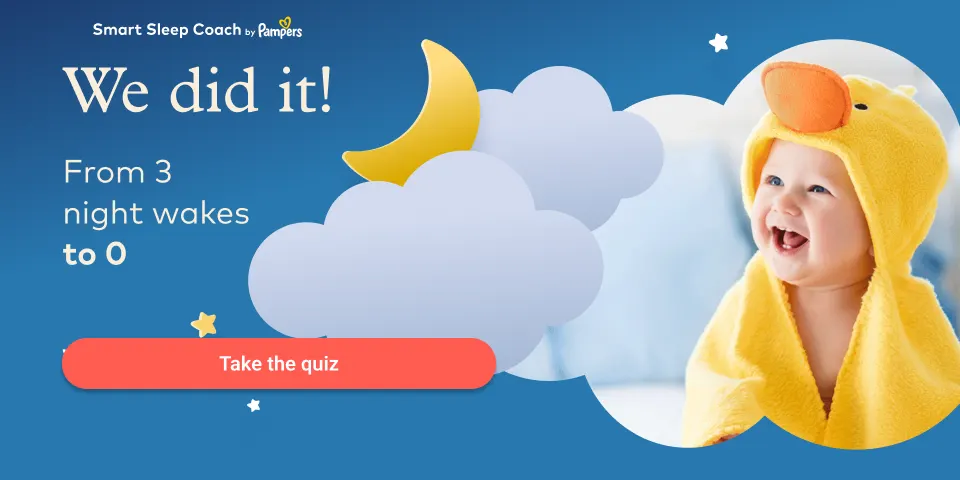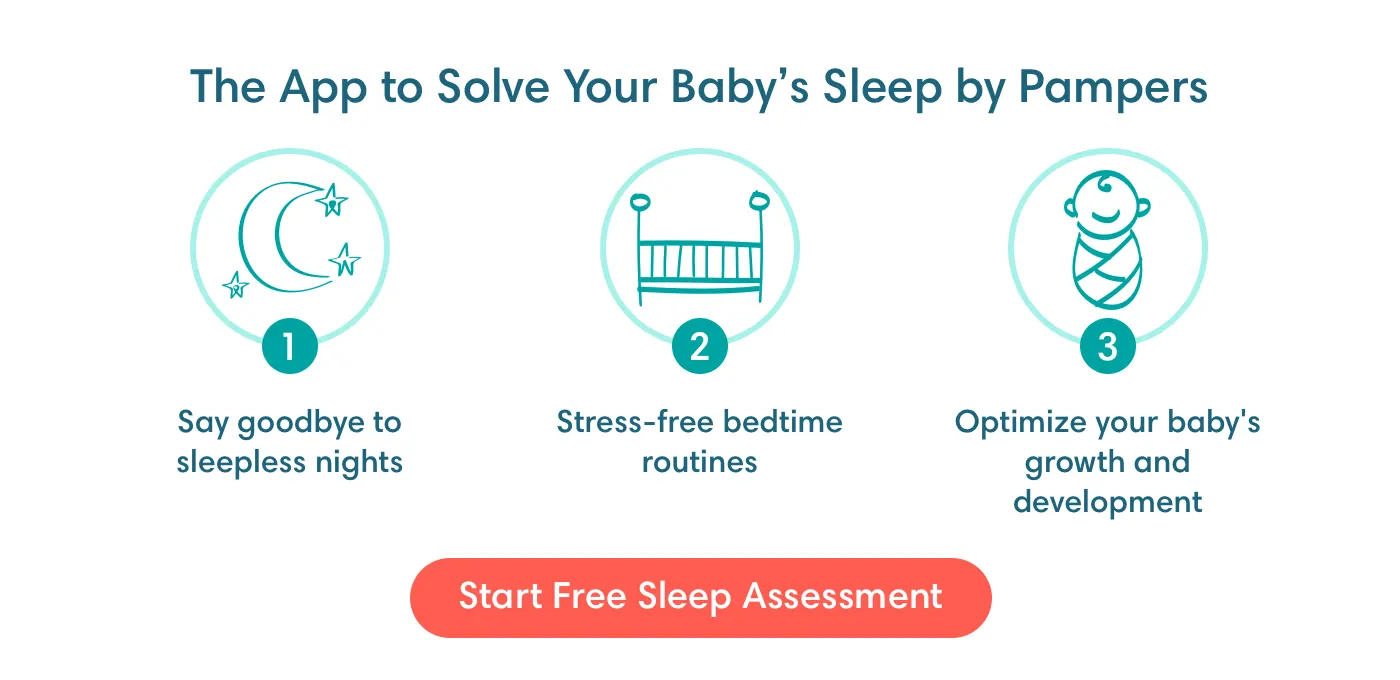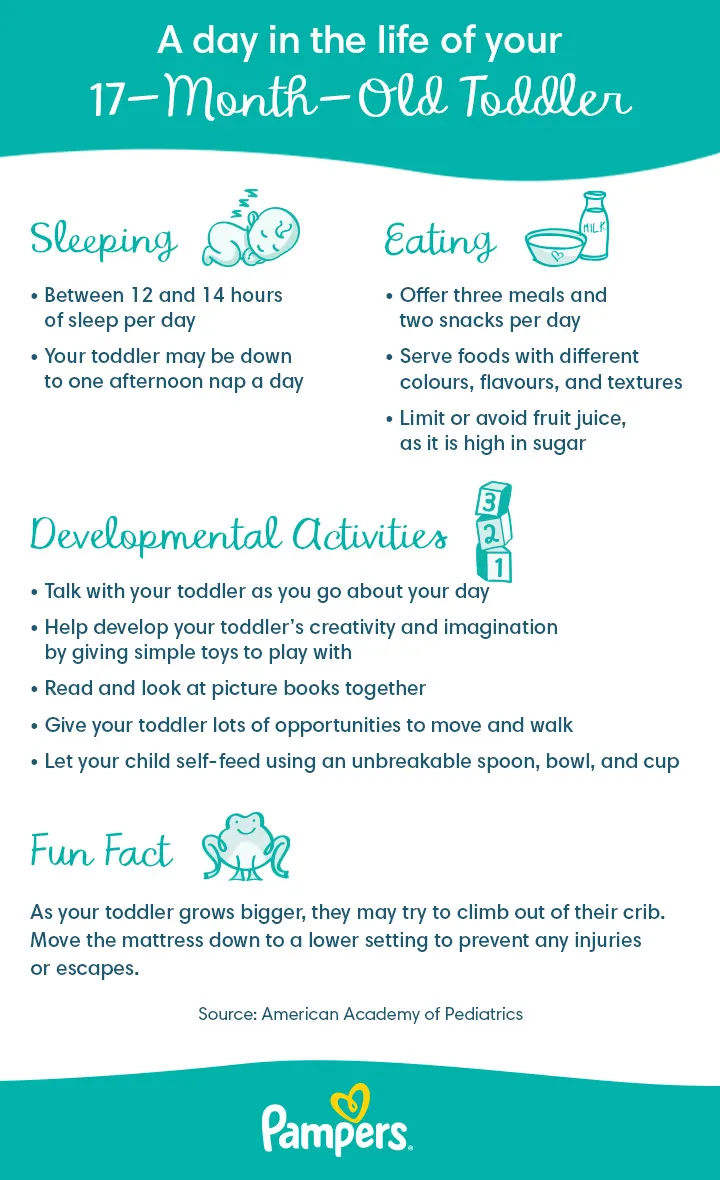17-Month-Old Baby: Developing Vocabulary
At about 17 months old, babies go through exciting language milestones, such as expanding their vocabulary, using verbs, and even speaking in short sentences. As for physical developments, 17-month-olds are improving hand and finger skills every day! Read on to learn more about what other milestones are happening and how you can support your child’s development this month.
Development: 17-Month-Old Milestones
Although your 17-month-old may reach certain milestones a little earlier or later, these are some of the developments you might see around this time:
Starts using active verbs. An exciting 17-month-old speech development is pronouncing words more clearly and using active verbs like “go” or “jump,” as well as directional words like “up,” “down,” “in,” or “out.” At this age, your little one may be able to speak in short sentences, like “go down slide” or “I jump up.”
Expands vocabulary. In terms of language development, you may find that your child’s vocabulary is growing more quickly than before. If you’re asking yourself, “What words should my 17-month-old be saying?”, you’re in for a treat! At this age, you may hear quite a few new words, especially those for favourite toys, people, and parts of the body. But because every child develops at a different pace, don’t get stuck on what children “should” be saying at this age. Instead, embrace and encourage your baby’s individual skills.
Improves hand and finger dexterity. Your child may be able to pick up small objects between their forefinger and thumb more easily than before, which is called the pincer grasp. As coordination improves, toddlers of this age might be able to scribble on a piece of paper or roll modeling clay in their hand. This opens up the opportunity for some fun toddler craft ideas!
How to Support Your 17-Month-Old’s Development
Here are some ways that you can support your 17-month-old’s developmental milestones:
Name everyday objects. Help your 17-month-old develop and expand vocabulary by naming and explaining common objects and everyday activities. For example, you could say a pan is used for cooking food and use toys to help illustrate this, such as by letting your toddler play with a toy kitchen or a toy phone.
Make brushing teeth fun. Establishing good oral hygiene and tooth-brushing habits can never start too early. Place a smidgen of toothpaste on your toddler’s brush and help them brush their teeth twice a day. (You’ll most likely need to be a helper until your child is about 6 to 8 years old.) To make this less of a chore and more of an enjoyable activity, you could play music for about two minutes while you brush your child’s teeth.
Allow your child a transitional object. It’s OK to let your 17-month-old baby use a blankie or a teddy bear for soothing. These types of objects might also help your child fall asleep and give comfort if waking up in the middle of the night. Just make sure that the object doesn’t have any parts that can become a choking hazard, like ribbons or buttons.
Weave reading into your daily routine. Tuck some books into your car or diaper bag so that you can pull one out when you need it. For example, when you're at the grocery store, give your toddler a board book or two to look at while you're wheeling around the shopping cart. Teaching your child to love reading is a great way to support and encourage future language skills.
17-Month-Old Baby Food: Mealtimes and Menus
Don’t be surprised if your toddler is a picky eater from time to time—this is a normal part of toddler and preschooler development. Your child’s appetite may fluctuate now that their growth rate has slowed, and as they form likes and dislikes about many things, not just food. Even with knowing this information, you may find it difficult to deal with the situation, but it won’t be impossible. The following are some tips and strategies for how to handle your 17-month-old baby’s food, especially when pickiness gets in the way of peaceful mealtimes:
Don’t force your toddler to eat. The more you urge or insist that your child eat a certain food or meal, the more they will resist it.
Give your child menu options. Offer your little one a few healthy foods even if they’re being picky—they’re bound to choose one of them. However, if your child doesn’t want to eat, save a plate for later when they get hungry. At 17 months old, a baby typically eats three small meals and two snacks per day.
Have a relaxing family meal together. Sit down to a family meal without the distractions of TV or smartphones and serve the same foods to everyone at the table, including your 17-month-old baby, though their portion will be smaller, of course. If your family likes spicy food, set aside some unseasoned portions for your little one. You may want to make sure that at least a couple of the foods on the menu is a favourite that’s more likely to be enjoyed!
Don’t use food as a reward. It’s not the best idea to reward your child with food, especially sweets. This approach can backfire and cause more food- and behaviour-related battles in the future. This is especially important if your 17-month-old is throwing tantrums, as giving into poor behaviour can cause future problems.
Don’t give up on introducing a new food. It may take as many as 10 tries to get your child to accept a certain food. But once you do succeed, keep going with a similar theme! For example, if you’ve finally succeeded in getting your little one to eat broccoli, you might introduce cauliflower next.
Make cooking and serving food enjoyable. Invite your child to help you prepare a few simple recipes. Perhaps they might help you stir pancake batter for your Saturday morning family breakfast. Then, when you serve your 17-month-old baby their food portions, be creative. For example, place berries on a pancake in the shape of a smiley face or make a rainbow out of bite-sized pieces of colourful vegetables.
The Art of Feeding a Toddler
Follow these guidelines for feeding your wriggly, picky, and/or opinionated 17-month-old baby:
Safe temperature. Make sure the food you give your little one isn’t too hot by testing it yourself.
Kid-friendly flavours. Avoid food that is too spicy, salty, buttery, or sweet.
Bite-sized pieces. Ensure the food is cut up into small pieces or mashed so that it’s easy for your child to eat. (Children under 4 years of age don’t chew with a grinding motion, so it’s important that foods are in bite-size pieces.)
Seated securely. Keep your toddler seated during mealtimes. This is important for reducing the risk of choking, which is more likely if your child is eating while playing or “eating on the run.”
Swallow before speaking. To further reduce the risk of chocking, teach your child to chew and swallow food before speaking.
One week at a time. Rather than focusing on your child getting enough daily nutrients, try to look at their menu in terms of one week. Your baby’s healthcare provider will track your 17-month-old’s weight on a growth chart, which tracks development over time. Believe it or not, your child will get the nutrients they need throughout the week, even if daily eating habits are sporadic!
17-Month-Old Sleep Schedule
At 17 months old, your baby typically needs between 12 and 14 hours of sleep per day. By this age, your little one may be down to one nap a day, but every child develops at a different pace. If your 17-month-old shows signs of sleep regression, it may be due to separation anxiety or not wanting to miss out on those fun, exciting milestones mentioned above.
To help ensure a safe and restful night’s sleep without too much waking up, here are some sleep tips to follow for your toddler:
Keep your child’s crib mattress at the lowest setting so they can’t climb out.
Ensure the crib is free of objects that your toddler could use to climb out, such as a large plush item or any toys that can be stacked.
Although this may be a while off, once your 17-month-old baby gets to the point where they can climb out of the crib, you may need to transition to a toddler bed.
Make sure the crib is positioned away from dangerous items, like windows, drapes, electrical outlets, and cords.
Remove any crib gyms, mobiles, or toys that hang over the crib, if you haven’t already, as they pose chocking and strangulation hazards
A Day in the Life of Your Toddler
Life is completely different with a 17-month-old in the house! Here’s what a typical day might look like:
Your Child’s Health and Safety: Being Outdoors
If the weather is good, your 17-month-old baby will enjoy spending time playing outside, whether it’s in the backyard, at the local park, or at a nearby playground. The following are some ways you can help protect your little one when outside with you:
Create a safe perimeter. To prevent your 17-month-old from going outside without your knowledge, install door locks that are out of their reach, baby gates, or even alarms that alert you to movement. These precautions can help prevent your child from wandering out to the swimming pool (if you have one), driveway, or street. Pools should have a fence on all four sides and a gate with a childproof lock that’s always locked.
Keep your child close. Whether you’re near a busy street, in a parking lot, standing on a driveway, or in a quiet residential neighbourhood, it’s a good idea to hold on to your child and keep a watchful eye on them.
Practise car safety. This is important when you or another family member might be backing out of your driveway. Make sure you know where your child is and that they can’t run behind the vehicle. Although many new cars have a rear-view backup camera, it’s still important to be extra vigilant and know where children are at all times. And when your car is not in use, make sure to lock the doors.
Apply sunscreen at all times. The sun’s invisible ultraviolet rays are harmful, even on foggy or hazy days and in winter, especially when UV rays reflect off snow. You’ll want to ensure your little one is protected. For your 17-month-old, look for a baby sunscreen that is SPF 30 or higher and one that offers protection from UVA and UVB light. Remember to reapply the sunscreen often, because even if the label says it’s sweat-proof and waterproof, no sunscreen really is.
Dress your child in appropriate clothing. Cotton clothing with long sleeves and long pants is good to protect your child's skin from the sun in warmer months. SPF clothing and wide-brimmed hats are also recommended to protect children from sunburn.
Make sure your child is drinking plenty of water. When kids play outside, it’s important that they stay hydrated. How much water should a 17-month-old drink? Dehydration can make your child ill, so it’s best to give your little one regular sips of water throughout the day, adding up to no more than eight ounces.
Stay with your child when in or near water. Don’t leave your child unattended near an open body of water, such as a lake or swimming pool.
Your Life as a Parent: Create a Network of Support
As a parent of a growing, developing, and energetic child, it’s totally OK to need or want help sometimes—all parents do! A network of support can come in handy when you need some help, and the support you get from family and friends can make all the difference. Here are some ideas for creating a support network:
Reach out to family and friends who live nearby. Family members and close friends are wonderful resources, especially if you need an impromptu babysitter. Plus, family and close friends will enjoy being part of your child’s life.
Create a network among your neighbours, especially if you all have children of a similar age. It’s easy to feel isolated when you keep to yourself. You may also find that this new network can come in handy when you need someone to look after your child, or you might want to carpool to daycare or a local event.
Join a local organization or parent-child group. Check out your local activity or community centres. By getting to know other parents in your area, you can share parenting tips, bond over the experiences you share in raising a child, and perhaps even help each other out from time to time.
Look to your healthcare provider for support and/or a referral to a therapist or counselors. Don’t be afraid to discuss your personal family problems. Your provider is there to help you find the support you need.
FAQs AT A GLANCE
During this month, your 17-month-old baby might be able to do things like:
- Build a tower out of blocks and then knock them down
- Insert different shapes, like squares, circles, or triangles, into matching holes
- Name familiar people or objects
- Speak using two- to four-word sentences
- Play make-believe games.
Keep in mind that each child develops at a unique pace, and your little one may develop these skills a little earlier or later than this.
Checklist for This Month
As you look forward to the 17-month-old development milestones, help you and your baby prepare with the handy checklist below:
Childproof the grandparents’ homes. If your little one will be staying at Grandma’s soon, check beforehand to make sure their home is babyproofed, which could include installing outlet covers, bumpers on furniture corners, and baby gates.
Consider riding a bicycle with your child. If the weather is nice, you might consider heading out for a ride with your little one as a passenger. You can attach a child carrier to the back of your bike, but keep in mind that there will be an extra safety precaution: You’ll need to increase your braking time as the weight of your toddler in the back makes your bike more unstable. Another option might be having your child ride in a bicycle towed trailer.
Watch over your toddler when around pets. You may believe that beloved Fido wouldn’t hurt your child, but you can’t predict what an animal’s behaviour might be around children, who often don't realise they are playing too roughly. It’s safest not to leave your baby alone with any pets and always make sure your dog, cat, bird, etc. is up to date with immunizations.
Plan time for yourself. Being a parent of an on-the-go toddler is a challenging job. Cut yourself some slack and take some time for yourself. Ask your babysitter, family member, or trusted friend to watch your child. Use the time to treat yourself to a dinner date or a movie with your partner, a spa treatment, or even a simple walk in the park to clear your mind—whatever relaxes you!
Get rewards. All those diaper changes deserve some rewards! Download the Pampers Club App and be rewarded for all your purchases.
The information in this article is based on the expert advice found in trusted medical and government sources, such as the American Academy of Pediatrics and the American College of Obstetricians and Gynecologists. You can find a full list of sources used for this article below. The content on this page should not replace professional medical advice. Always consult medical professionals for full diagnosis and treatment.
17 Month Old - checklist






